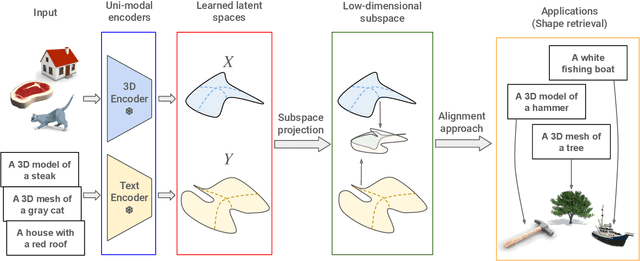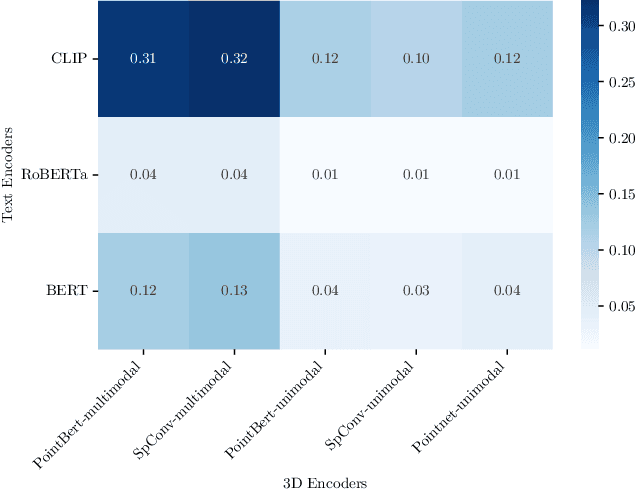Qixing Huang
Positional Encoding Field
Oct 23, 2025Abstract:Diffusion Transformers (DiTs) have emerged as the dominant architecture for visual generation, powering state-of-the-art image and video models. By representing images as patch tokens with positional encodings (PEs), DiTs combine Transformer scalability with spatial and temporal inductive biases. In this work, we revisit how DiTs organize visual content and discover that patch tokens exhibit a surprising degree of independence: even when PEs are perturbed, DiTs still produce globally coherent outputs, indicating that spatial coherence is primarily governed by PEs. Motivated by this finding, we introduce the Positional Encoding Field (PE-Field), which extends positional encodings from the 2D plane to a structured 3D field. PE-Field incorporates depth-aware encodings for volumetric reasoning and hierarchical encodings for fine-grained sub-patch control, enabling DiTs to model geometry directly in 3D space. Our PE-Field-augmented DiT achieves state-of-the-art performance on single-image novel view synthesis and generalizes to controllable spatial image editing.
SounDiT: Geo-Contextual Soundscape-to-Landscape Generation
May 19, 2025Abstract:We present a novel and practically significant problem-Geo-Contextual Soundscape-to-Landscape (GeoS2L) generation-which aims to synthesize geographically realistic landscape images from environmental soundscapes. Prior audio-to-image generation methods typically rely on general-purpose datasets and overlook geographic and environmental contexts, resulting in unrealistic images that are misaligned with real-world environmental settings. To address this limitation, we introduce a novel geo-contextual computational framework that explicitly integrates geographic knowledge into multimodal generative modeling. We construct two large-scale geo-contextual multimodal datasets, SoundingSVI and SonicUrban, pairing diverse soundscapes with real-world landscape images. We propose SounDiT, a novel Diffusion Transformer (DiT)-based model that incorporates geo-contextual scene conditioning to synthesize geographically coherent landscape images. Furthermore, we propose a practically-informed geo-contextual evaluation framework, the Place Similarity Score (PSS), across element-, scene-, and human perception-levels to measure consistency between input soundscapes and generated landscape images. Extensive experiments demonstrate that SounDiT outperforms existing baselines in both visual fidelity and geographic settings. Our work not only establishes foundational benchmarks for GeoS2L generation but also highlights the importance of incorporating geographic domain knowledge in advancing multimodal generative models, opening new directions at the intersection of generative AI, geography, urban planning, and environmental sciences.
RayZer: A Self-supervised Large View Synthesis Model
May 01, 2025



Abstract:We present RayZer, a self-supervised multi-view 3D Vision model trained without any 3D supervision, i.e., camera poses and scene geometry, while exhibiting emerging 3D awareness. Concretely, RayZer takes unposed and uncalibrated images as input, recovers camera parameters, reconstructs a scene representation, and synthesizes novel views. During training, RayZer relies solely on its self-predicted camera poses to render target views, eliminating the need for any ground-truth camera annotations and allowing RayZer to be trained with 2D image supervision. The emerging 3D awareness of RayZer is attributed to two key factors. First, we design a self-supervised framework, which achieves 3D-aware auto-encoding of input images by disentangling camera and scene representations. Second, we design a transformer-based model in which the only 3D prior is the ray structure, connecting camera, pixel, and scene simultaneously. RayZer demonstrates comparable or even superior novel view synthesis performance than ``oracle'' methods that rely on pose annotations in both training and testing. Project: https://hwjiang1510.github.io/RayZer/
HUMOTO: A 4D Dataset of Mocap Human Object Interactions
Apr 14, 2025Abstract:We present Human Motions with Objects (HUMOTO), a high-fidelity dataset of human-object interactions for motion generation, computer vision, and robotics applications. Featuring 736 sequences (7,875 seconds at 30 fps), HUMOTO captures interactions with 63 precisely modeled objects and 72 articulated parts. Our innovations include a scene-driven LLM scripting pipeline creating complete, purposeful tasks with natural progression, and a mocap-and-camera recording setup to effectively handle occlusions. Spanning diverse activities from cooking to outdoor picnics, HUMOTO preserves both physical accuracy and logical task flow. Professional artists rigorously clean and verify each sequence, minimizing foot sliding and object penetrations. We also provide benchmarks compared to other datasets. HUMOTO's comprehensive full-body motion and simultaneous multi-object interactions address key data-capturing challenges and provide opportunities to advance realistic human-object interaction modeling across research domains with practical applications in animation, robotics, and embodied AI systems. Project: https://jiaxin-lu.github.io/humoto/ .
CADCrafter: Generating Computer-Aided Design Models from Unconstrained Images
Apr 10, 2025Abstract:Creating CAD digital twins from the physical world is crucial for manufacturing, design, and simulation. However, current methods typically rely on costly 3D scanning with labor-intensive post-processing. To provide a user-friendly design process, we explore the problem of reverse engineering from unconstrained real-world CAD images that can be easily captured by users of all experiences. However, the scarcity of real-world CAD data poses challenges in directly training such models. To tackle these challenges, we propose CADCrafter, an image-to-parametric CAD model generation framework that trains solely on synthetic textureless CAD data while testing on real-world images. To bridge the significant representation disparity between images and parametric CAD models, we introduce a geometry encoder to accurately capture diverse geometric features. Moreover, the texture-invariant properties of the geometric features can also facilitate the generalization to real-world scenarios. Since compiling CAD parameter sequences into explicit CAD models is a non-differentiable process, the network training inherently lacks explicit geometric supervision. To impose geometric validity constraints, we employ direct preference optimization (DPO) to fine-tune our model with the automatic code checker feedback on CAD sequence quality. Furthermore, we collected a real-world dataset, comprised of multi-view images and corresponding CAD command sequence pairs, to evaluate our method. Experimental results demonstrate that our approach can robustly handle real unconstrained CAD images, and even generalize to unseen general objects.
Reconstructing Humans with a Biomechanically Accurate Skeleton
Mar 27, 2025



Abstract:In this paper, we introduce a method for reconstructing 3D humans from a single image using a biomechanically accurate skeleton model. To achieve this, we train a transformer that takes an image as input and estimates the parameters of the model. Due to the lack of training data for this task, we build a pipeline to produce pseudo ground truth model parameters for single images and implement a training procedure that iteratively refines these pseudo labels. Compared to state-of-the-art methods for 3D human mesh recovery, our model achieves competitive performance on standard benchmarks, while it significantly outperforms them in settings with extreme 3D poses and viewpoints. Additionally, we show that previous reconstruction methods frequently violate joint angle limits, leading to unnatural rotations. In contrast, our approach leverages the biomechanically plausible degrees of freedom making more realistic joint rotation estimates. We validate our approach across multiple human pose estimation benchmarks. We make the code, models and data available at: https://isshikihugh.github.io/HSMR/
PASTA: Part-Aware Sketch-to-3D Shape Generation with Text-Aligned Prior
Mar 17, 2025Abstract:A fundamental challenge in conditional 3D shape generation is to minimize the information loss and maximize the intention of user input. Existing approaches have predominantly focused on two types of isolated conditional signals, i.e., user sketches and text descriptions, each of which does not offer flexible control of the generated shape. In this paper, we introduce PASTA, the flexible approach that seamlessly integrates a user sketch and a text description for 3D shape generation. The key idea is to use text embeddings from a vision-language model to enrich the semantic representation of sketches. Specifically, these text-derived priors specify the part components of the object, compensating for missing visual cues from ambiguous sketches. In addition, we introduce ISG-Net which employs two types of graph convolutional networks: IndivGCN, which processes fine-grained details, and PartGCN, which aggregates these details into parts and refines the structure of objects. Extensive experiments demonstrate that PASTA outperforms existing methods in part-level editing and achieves state-of-the-art results in sketch-to-3D shape generation.
Escaping Plato's Cave: Towards the Alignment of 3D and Text Latent Spaces
Mar 07, 2025



Abstract:Recent works have shown that, when trained at scale, uni-modal 2D vision and text encoders converge to learned features that share remarkable structural properties, despite arising from different representations. However, the role of 3D encoders with respect to other modalities remains unexplored. Furthermore, existing 3D foundation models that leverage large datasets are typically trained with explicit alignment objectives with respect to frozen encoders from other representations. In this work, we investigate the possibility of a posteriori alignment of representations obtained from uni-modal 3D encoders compared to text-based feature spaces. We show that naive post-training feature alignment of uni-modal text and 3D encoders results in limited performance. We then focus on extracting subspaces of the corresponding feature spaces and discover that by projecting learned representations onto well-chosen lower-dimensional subspaces the quality of alignment becomes significantly higher, leading to improved accuracy on matching and retrieval tasks. Our analysis further sheds light on the nature of these shared subspaces, which roughly separate between semantic and geometric data representations. Overall, ours is the first work that helps to establish a baseline for post-training alignment of 3D uni-modal and text feature spaces, and helps to highlight both the shared and unique properties of 3D data compared to other representations.
MegaSynth: Scaling Up 3D Scene Reconstruction with Synthesized Data
Dec 18, 2024



Abstract:We propose scaling up 3D scene reconstruction by training with synthesized data. At the core of our work is MegaSynth, a procedurally generated 3D dataset comprising 700K scenes - over 50 times larger than the prior real dataset DL3DV - dramatically scaling the training data. To enable scalable data generation, our key idea is eliminating semantic information, removing the need to model complex semantic priors such as object affordances and scene composition. Instead, we model scenes with basic spatial structures and geometry primitives, offering scalability. Besides, we control data complexity to facilitate training while loosely aligning it with real-world data distribution to benefit real-world generalization. We explore training LRMs with both MegaSynth and available real data. Experiment results show that joint training or pre-training with MegaSynth improves reconstruction quality by 1.2 to 1.8 dB PSNR across diverse image domains. Moreover, models trained solely on MegaSynth perform comparably to those trained on real data, underscoring the low-level nature of 3D reconstruction. Additionally, we provide an in-depth analysis of MegaSynth's properties for enhancing model capability, training stability, and generalization.
FiffDepth: Feed-forward Transformation of Diffusion-Based Generators for Detailed Depth Estimation
Dec 01, 2024



Abstract:Monocular Depth Estimation (MDE) is essential for applications like 3D scene reconstruction, autonomous navigation, and AI content creation. However, robust MDE remains challenging due to noisy real-world data and distribution gaps in synthetic datasets. Existing methods often struggle with low efficiency, reduced accuracy, and lack of detail. To address this, we propose an efficient approach for leveraging diffusion priors and introduce FiffDepth, a framework that transforms diffusion-based image generators into a feedforward architecture for detailed depth estimation. By preserving key generative features and integrating the strong generalization capabilities of models like dinov2, FiffDepth achieves enhanced accuracy, stability, and fine-grained detail, offering a significant improvement in MDE performance across diverse real-world scenarios.
 Add to Chrome
Add to Chrome Add to Firefox
Add to Firefox Add to Edge
Add to Edge